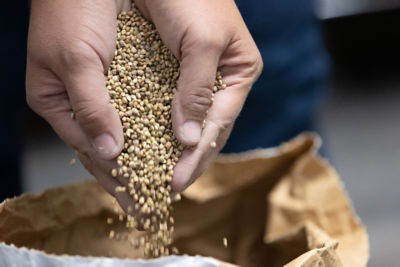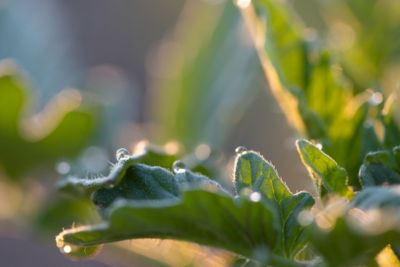Click here to download a PDF version of this spotlight.
» Squash vine borers are pests of summer squash and some winter squash varieties.
» Squash vine borer larvae feed inside stems and damage vascular tissues.
» Cultural practices and insecticide applications can help manage squash vine borer infestations.
The squash vine borer, Melittia cucurbitae, is an insect pest of wild and crop species of cucurbits in North America, east of the Rocky Mountains, from Central America to Canada. Melittia calabaza is a related species that attacks cucurbits in the southwestern U.S.1,2 M. cucurbitae is a common pest on summer squash, some varieties of winter squash, and pumpkin. It is a rare pest on cucumber, melon, and watermelon.1,3
 Figure 1. The adult (moth) stage of the squash vine borer, Melittia cucurbitae. Ansel Oommen, Bugwood.org.
Figure 1. The adult (moth) stage of the squash vine borer, Melittia cucurbitae. Ansel Oommen, Bugwood.org.
IDENTIFICATION
Squash vine borer (SVB) adults are moths that look like wasps (Figure 1) and are mostly active during the day. Their bodies are three-quarters to one inch long with gray to dull orange abdomens that are marked with black dots. They have two pairs of wings with a one- to one-and-a-half-inch wingspan. The front pair of wings is olive to metallic green, and the hind pair is clear. The hind wings fold over the back of the moth when it is at rest. The hind legs are tufted with orange and black markings.1,2,3 Females lay eggs that are oval to flat, reddish brown, and very small (1/25th inch long). White to cream-colored larvae (caterpillars) with brown heads emerge when the eggs hatch. The larvae grow up to 1 inch long before they pupate.
LIFE CYCLE
SVB larvae feed mostly on wild and cultivated Cucurbita species, including Cucurbita pepo (summer squashes and some winter squashes/pumpkins) and Cucurbita maxima (some winter squashes). However, the squash vine borer can only complete its life cycle on varieties of Cucurbita pepo. The borer species present in the southwestern U.S. (M. calabaza) can complete its life cycle on both C. pepo and C. maxima host plants.2
The insects survive over the winter as pupae in the soil and emerge as adult moths in mid-summer. They complete their life cycle in about sixty days, and the larvae are only active for four to six weeks. There can be two generations of SVB per year in warmer, southern areas, and usually only one per year in cooler, more northern areas.1,2 Female moths lay eggs singly near the bases of plants, leaf stalks, and vines. The eggs hatchmin seven to fifteen days, and the emerged larvae quickly borem into stems and leaf stalks and begin to feed. After feeding for four to six weeks, the larvae exit the plant, burrow into the soil, and pupate.1,3
DAMAGE
Larvae feed within the plant stems, where they are hidden from view and are easily overlooked. Larval feeding damages the stem’s vascular system, disrupting the movement of water and nutrients through the plants (Figure 2).1,2,3 With close inspection, small, round entry holes in the stems filled with greenish frass can be seen. Often, the first indication of an SVB infestation is the wilting of affected plants during the heat of the day, with recovery overnight. As the internal damage progresses, plants will remain wilted in the morning. Eventually, plants or individual vines will collapse and die. A single plant can be attacked by several larvae. The wounds in the stems also allow the entry of stem-rotting pathogens that further damage the tissue. Later in the season, the larvae may also enter and feed within squash fruit. SVB is usually more of a problem for smaller plantings and not a substantial problem for large-scale squash production systems.2
 Figure 2. A squash vine borer larva feeding inside a squash stem. Gerald Holmes, Cal Poly San Luis Obispo, Bugwood.org.
Figure 2. A squash vine borer larva feeding inside a squash stem. Gerald Holmes, Cal Poly San Luis Obispo, Bugwood.org.
MANAGEMENT
SVB moth activity can be monitored with the use of pheromone traps that attract male moths. Related moth species can also be attracted to the traps, so the person monitoring the traps needs to be able to distinguish SVB moths from the others that might be present. No action thresholds have been established for SVB based on trap counts.2,3
Cultural practices can be used to help lower SVB populations in the field. Rotate to non-host crops and avoid planting in fields with a recent history of SVB infestation because overwintering pupae may be present in the soil.3,4 Plowing in crop debris promptly after harvest can help eliminate larvae and reduce the number of overwintering pupae in the soil. Plowing the field the following spring can also help eliminate the overwintering pupae.5
Highly susceptible crop varieties can be used as trap crops to help protect crops less preferred by SVB. When SVB eggs have been laid on the trap crop and larvae start to emerge, the trap crop can be destroyed or treated with insecticides. Row covers can also be used to exclude SVB from laying eggs on crop plants.2,3 However, the covers have to be removed during periods of pollination.
There are differences in susceptibility to SVB among squash varieties, but acceptable levels of resistance are not available in commercial squash varieties.3
Insecticide applications can be used to help protect plants from SVB infestations. The insecticides need to be applied before the eggs are laid and larvae emerge. Larvae must come into contact with the insecticide before they burrow into the stem. Once inside the stem, the larvae are generally protectedfrom insecticides and difficult to control.2,3,5 Pollinators and other beneficial insects need to be considered when applying insecticides. Applying insecticides late in the day or early evening can help reduce the effect on honeybees because bees are most active in the morning and early afternoon hours. Selecting products that are less harmful to bees and other beneficial insects can also help reduce the impact on these organisms. Always read current product labels and follow the recommendations and restrictions for the specific crop and target pest. Consult regional production and pest management guides for available insecticides. The use of biological control agents has not been shown to be adequately effective against SVB.3
SOURCES
1 Mahr, S. Squash vine borer, Melittia cucurbitae. University of Wisconsin-Madison, Wisconsin
Horticulture. https://hort.extension.wisc.edu/articles/squash-vine-borer-melittia-curcurbitae/.
2 Capinera, J. 2017. Squash vine borer. In Keinath, A., Wintermantel, W., and Zitter, T.
(Eds.) Compendium of Cucurbit Diseases and Pests, Second Edition. The American
Phytopathological Society. St. Paul. MN.
3 Hutchinson, B. 2022. Squash vine borers. University of Minnesota Extension, Yard and
Garden Insects. https://extension.umn.edu/yard-and-garden-insects/squash-vine-borers.
4 Wehner, T., Naegele, R., Myers, J., Dhillon, N., and Crosby, K. Cucurbits, 2nd Edition (Crop
Production Science in Horticulture Book 6) (pp. 322-323). CABI.
5 2023. Squash vine borer. PennState Extension. https://extension.psu.edu/squash-vine-borer.
Websites verified 11/30/2023
ADDITIONAL INFORMATION
For additional agronomic information, please contact your local seed representative. Performance may vary, from location to location and from year to year, as local growing, soil and environmental conditions may vary. Growers should evaluate data from multiple locations and years whenever possible and should consider the impacts of these conditions on their growing environment. The recommendations in this article are based upon information obtained from the cited sources and should be used as a quick reference for informationabout vegetable production. The content of this article should not be substituted for the professional opinion of a producer, grower, agronomist, pathologist and similar professional dealing with vegetable crops.
BAYER GROUP DOES NOT WARRANT THE ACCURACY OF ANY INFORMATION OR TECHNICAL ADVICE PROVIDED HEREIN AND DISCLAIMS ALL LIABILITY FOR ANY CLAIM INVOLVING SUCH INFORMATION OR ADVICE.
5911_279851 Published 11/09/2023




